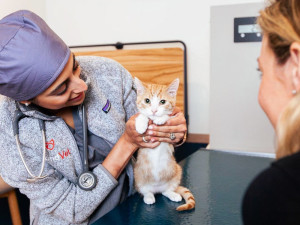An Oregon Resident Just Caught the Bubonic Plague, Likely From Their Cat
Here is everything pet parents need to know.

share article

Your pet wants you to read our newsletter. (Then give them a treat.)
A cat parent in central Oregon has been diagnosed with bubonic plague (yes, you read that right), which they reportedly got from their symptomatic cat, per a statementopens in a new tab from health officials on the Deschutes County website. The statement reads that the illness was caught early, “posing little risk to the community.” There have been no other cases identified in the investigation.
“All close contacts of the resident and their pet have been contacted and provided medication to prevent illness,” said Dr. Richard Fawcett, Deschutes county health officer, in the statement.
Bubonic plague symptoms and how to stay safe
The plague is a zoonotic diseaseopens in a new tab, meaning humans can catch it from animals. Per Deschutes County, symptoms in humans usually occur about two to eight days after they’re exposed to an animal or flea that has the disease. These can include: “sudden onset of fever, nausea, weakness, chills, muscle aches, and/or visibly swollen lymph nodes called buboes.” In the statement, Oregon Health Authority confirmed that the last case of this plague in Oregon was in 2015.
Health officials advise for pet parents to take the following steps to protect themselves from this rare illness:
Keep all pets on leash outdoors and treat them with flea preventionopens in a new tab.
Don’t let your pet come into contact with wild rodents (including while hunting).
Never touch dead rodents or fleas.
Don’t feed any of these animals.
Wear long pants while outside to avoid contact with fleas.
Don’t camp near areas where dead rodents have been spotted.
The history of the plague in the U.S. and how to treat it
Per the Centers for Disease Control (opens in a new tabCDC), the plague was first introduced to the U.S. in 1900 by rat-infested steamships. “The last urban plague epidemic in the United States occurred in Los Angeles from 1924 through 1925,” the CDC sites statesopens in a new tab. Plague then spread from urban rats to rural rodent species, and became entrenched in many areas of the western United States. Since that time, plague has occurred as scattered cases in rural areas.”
The CDC statesopens in a new tab that the plague is serious but usually treatable with antibiotics for seven to 14 days. The organization continues with a warning: “If you live or have recently traveled to the western U.S. or any other plague endemic area and have symptoms suggestive of plague, seek health care immediately.”

Hilary Weaver
Hilary Weaver is the senior editor at The Wildest. She has previously been an editor at The Spruce Pets, ELLE, and The Cut. She was a staff writer at Vanity Fair from 2016 to 2019, and her work has been featured in Esquire, Refinery 29, BuzzFeed, Parade, and more. She lives with her herding pups, Georgie and Charlie.
Related articles
![man and lab puppy on park road]() opens in a new tab
opens in a new tabWhen, Exactly, Should You Vaccinate Your Puppy?
If it’s time for a round of shots (no, not that kind), follow this guide.
![man and lab puppy on park road]() opens in a new tab
opens in a new tabWhen, Exactly, Should You Vaccinate Your Puppy?
If it’s time for a round of shots (no, not that kind), follow this guide.
![A smiling veterinarian holding a cat]() opens in a new tab
opens in a new tabVets Are at High Risk For Compassion Fatigue—Here Are 4 Ways You Can Help
It’s extra important to be nice to the vet in your life.
![Cavalier King Charles spaniel puppy running in a garden]() opens in a new tab
opens in a new tabParvovirus: How to Identify and Treat Parvo Symptoms in Puppies
The potentially deadly virus can be prevented with one simple step.
![A happy woman is lying on a bed, her dog smelling her face.]() opens in a new tab
opens in a new tab9 Diseases You Can (and Definitely Can’t) Catch From Your Dog
Here’s what you can scratch off your “Worry About This” list.
![Sad tan and white puppy laying on the floor in the living room]() opens in a new tab
opens in a new tabMonkeypox Has Been Found in a Dog: Here’s What You Need to Know
A key number to remember here: 21.






